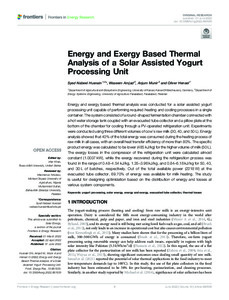Datum
2022-06-01Schlagwort
333 Boden- und Energiewirtschaft JoghurtherstellungSonnenenergieExergieEnergieWärmeverlustMetadata
Zur Langanzeige
Aufsatz

Energy and Exergy Based Thermal Analysis of a Solar Assisted Yogurt Processing Unit
Zusammenfassung
Energy and exergy based thermal analysis was conducted for a solar assisted yogurt processing unit capable of performing required heating and cooling processes in a single container. The system consisted of a round-shaped fermentation chamber connected with a hot water storage tank coupled with an evacuated tube collector and a pillow plate at the bottom of the chamber for cooling through a PV-operated refrigeration unit. Experiments were conducted using three different volumes of cow’s raw milk (30, 40, and 50 L). Energy analysis showed that 40% of the total energy was consumed during the heating process of raw milk in all cases, with an overall heat transfer efficiency of more than 80%. The specific product energy was calculated to be lower (485 kJ/kg) for the higher volume of milk (50 L). The exergy losses in the compressor of the refrigeration unit were calculated almost constant (1.0037 kW), while the exergy recovered during the refrigeration process was found in the range of 0.48–4.54 kJ/kg, 1.35–3.96 kJ/kg, and 0.84–6.18 kJ/kg for 50, 40, and 30 L of batches, respectively. Out of the total available power (2218 W) at the evacuated tube collector, 69.70% of energy was available for milk heating. The study is useful for designing optimization based on the distribution of energy and losses at various system components.
Zitierform
In: Frontiers in Energy Research Volume 10 (2022-06-01) eissn:2296-598XFörderhinweis
Gefördert durch den Publikationsfonds der Universität KasselZitieren
@article{doi:10.17170/kobra-202206146341,
author={Husnain, Syed Nabeel and Amjad, Waseem and Munir, Anjum and Hensel, Oliver},
title={Energy and Exergy Based Thermal Analysis of a Solar Assisted Yogurt Processing Unit},
journal={Frontiers in Energy Research},
year={2022}
}
0500 Oax
0501 Text $btxt$2rdacontent
0502 Computermedien $bc$2rdacarrier
1100 2022$n2022
1500 1/eng
2050 ##0##http://hdl.handle.net/123456789/13927
3000 Husnain, Syed Nabeel
3010 Amjad, Waseem
3010 Munir, Anjum
3010 Hensel, Oliver
4000 Energy and Exergy Based Thermal Analysis of a Solar Assisted Yogurt Processing Unit / Husnain, Syed Nabeel
4030
4060 Online-Ressource
4085 ##0##=u http://nbn-resolving.de/http://hdl.handle.net/123456789/13927=x R
4204 \$dAufsatz
4170
5550 {{Joghurtherstellung}}
5550 {{Sonnenenergie}}
5550 {{Exergie}}
5550 {{Energie}}
5550 {{Wärmeverlust}}
7136 ##0##http://hdl.handle.net/123456789/13927
<resource xsi:schemaLocation="http://datacite.org/schema/kernel-2.2 http://schema.datacite.org/meta/kernel-2.2/metadata.xsd"> 2022-06-20T09:53:39Z 2022-06-20T09:53:39Z 2022-06-01 doi:10.17170/kobra-202206146341 http://hdl.handle.net/123456789/13927 Gefördert durch den Publikationsfonds der Universität Kassel eng Namensnennung 4.0 International http://creativecommons.org/licenses/by/4.0/ yogurt processing solar energy energy and exergy evacuated tube collector thermal losses 333 Energy and Exergy Based Thermal Analysis of a Solar Assisted Yogurt Processing Unit Aufsatz Energy and exergy based thermal analysis was conducted for a solar assisted yogurt processing unit capable of performing required heating and cooling processes in a single container. The system consisted of a round-shaped fermentation chamber connected with a hot water storage tank coupled with an evacuated tube collector and a pillow plate at the bottom of the chamber for cooling through a PV-operated refrigeration unit. Experiments were conducted using three different volumes of cow’s raw milk (30, 40, and 50 L). Energy analysis showed that 40% of the total energy was consumed during the heating process of raw milk in all cases, with an overall heat transfer efficiency of more than 80%. The specific product energy was calculated to be lower (485 kJ/kg) for the higher volume of milk (50 L). The exergy losses in the compressor of the refrigeration unit were calculated almost constant (1.0037 kW), while the exergy recovered during the refrigeration process was found in the range of 0.48–4.54 kJ/kg, 1.35–3.96 kJ/kg, and 0.84–6.18 kJ/kg for 50, 40, and 30 L of batches, respectively. Out of the total available power (2218 W) at the evacuated tube collector, 69.70% of energy was available for milk heating. The study is useful for designing optimization based on the distribution of energy and losses at various system components. open access Husnain, Syed Nabeel Amjad, Waseem Munir, Anjum Hensel, Oliver doi:10.3389/fenrg.2022.887639 Joghurtherstellung Sonnenenergie Exergie Energie Wärmeverlust publishedVersion eissn:2296-598X Frontiers in Energy Research Volume 10 false 887639 </resource>
Die folgenden Lizenzbestimmungen sind mit dieser Ressource verbunden:


